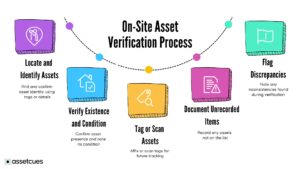Fixed asset verification is the process of physical verifying and reconciling your company’s assets to ensure the records match reality. It confirms that each asset on the books actually exists, in the recorded location and condition, and uncovers any discrepancies.
This process ensures audit compliance and accurate reporting. It includes planning, counting, reconciling, updating, and reporting. Meanwhile, tools like mobile scanners or RFID boost efficiency and accuracy.
Read More: For an in-depth exploration of asset verification concepts and methods, see our A Complete Guide to Physical Asset Audits on the AssetCues blog.
1. Planning and Preparation for Asset Verification
A well-structured plan is the foundation of a successful asset verification process. Start by defining the scope and approach of verification, and ensure all resources are in place before the count begins. Key planning steps include:
-
Define Scope and Method:
Decide asset categories and locations for verification. Then, select a method—wall-to-wall or file-to-floor. Use wall-to-wall if records are outdated; otherwise, file-to-floor works well.
-
Assign a Verification Team:
Appoint a team with clear roles and responsibilities. Then, include people from finance or audit, and consider involving department asset custodians. Ensure one person oversees the process, while others handle counting, data recording, and supervision.
-
Set Timeline and Communication:
Establish a schedule that minimizes disruption to operations. Communicate the verification plan to all relevant departments ahead of time – let asset custodians know when and how the physical count will happen to avoid assets being moved during the audit.
-
Prepare Tools and Tags:
Prepare all tools for a smooth physical count. Load the asset register into an app or print it. Also, ready scanners, tags, printers, and clipboards. Use mobile apps and RFID/barcodes to speed up work and cut errors. These tools ensure accurate and efficient verification.
-
Compile an Asset List:
Ensure the asset register is up to date with all key details. It acts as your checklist during verification. Start with accurate records to avoid chasing phantom assets or missing real ones. This step builds the foundation for a successful audit.
-
Logistics and Training:
Get access permissions for restricted areas in advance. Then, train the team on tag reading, scanning, and documentation. Use a checklist template to standardize how details are recorded. This ensures consistent and accurate asset identification.
Pro Tip: If creating a clean asset register is part of your project (for example, after mergers or poor record-keeping), consider professional help. AssetCues offers Fixed Asset Register Services to build a compliant, consolidated register — providing a solid foundation before you verify assets.
2. Conducting the Physical Asset Verification On-Site

This step forms the core of asset verification—physically inspecting each asset in scope. Typically, teams move through locations with a list or app, checking off items. To ensure success, follow these steps:
-
Locate and Identify Assets:
First, locate each item in the field and confirm its identity. Then, scan asset tags to instantly match records during verification. If tags are missing, use serial number or model details. Finally, tag the asset for future tracking. This step ensures every asset is properly verified and recorded.
-
Verify Existence and Condition:
Next, physically confirm that the asset exists and note its condition. Check if it is operational, in good repair, or damaged/obsolete. Also, ensure the asset is in the correct location and assigned to the right user or department. This step helps ensure the asset register reflects reality on the ground.
-
Tag or Scan Assets:
Meanwhile, tag unmarked assets during verification for future tracking ease. If tagged, scan each with a mobile device or scanner. Tags speed up work and reduce manual errors. They also prevent confusion between similar-looking assets. This ensures accurate and efficient asset logging.
-
Document Unrecorded Items:
Simultaneously, look for extra assets not listed in your register. Often, you’ll find unrecorded or wrongly disposed items. Log each with details like location, description, and value. Then, add them to the register for proper tracking. This helps maintain a complete and accurate asset record.
-
Flag Discrepancies:
Finally, note all discrepancies during the physical count process. Common issues include missing, moved, or unrecorded assets. Flag mismatched details like tag numbers or locations. Mark these in a log or directly on the checklist. This helps guide reconciliation and follow-up actions later.
If asset volumes are high or time is short, break the verification into smaller chunks (by location or category), or conduct spot checks for low-value items. Also, use mobile asset verification software to capture data in real time—scanning assets updates their verified status instantly, saving time during reconciliation.

Need hands-on help with asset verification?
Need hands-on help with asset verification?

3. Reconciling Discrepancies and Updating Records
After counting, start reconciliation by comparing findings to the register. This step corrects mismatches and updates records for accuracy. Regular reconciliation ensures compliance and prevents mismanagement. It also strengthens control over your asset data. Now, follow these steps to reconcile effectively:
-
Compare Physical vs. Records:
Match field results with the asset register line by line. Then, flag all differences like missing, extra, or mismatched assets. Common issues include wrong tags, incorrect locations, or missing entries. Clearly list each discrepancy for follow-up investigation. This ensures complete and accurate reconciliation.
-
Investigate and Resolve Issues:
Investigate each discrepancy to uncover its root cause. Then, trace missing items, verify transfers, or check disposal records. Also, review paperwork or ownership for unrecorded assets. Speak with custodians or managers for clarification. The aim is to locate assets or accurately explain record mismatches.
-
Update the Asset Register:
Once resolved, promptly update the records to reflect asset reality. Then, write off missing assets after full confirmation they’re gone. Similarly, add newly found assets with accurate details and valuations. Also, correct data errors such as status, condition, or location. Finally, always document changes with proper approval for compliance tracking.
-
Ensure Policy Compliance:
Check that all updates follow accounting policies and standards. Then, get approvals for write-offs based on capitalization thresholds. Ensure changes align with rules on depreciation and disposals. This prevents misstatements and audit issues. A compliant register keeps asset data trustworthy and accurate.
-
Reconcile Financials if Needed:
If asset value changes are significant, inform the finance team. Adjust the general ledger or statements as needed. Record catch-up depreciation or impair missing assets. Sync financials with the verified asset register. This keeps financial reporting accurate and aligned with reality.
Document each discrepancy and its resolution to strengthen your report and audit readiness. Moreover, transparent investigation and regular reconciliation prevent losses, ensure compliance, and build long-term trust.
4. Reporting Results and Continuous Improvement
Once the asset register is updated and accurate, the last step is to compile a verification report and learn from the process. A well-prepared report provides an audit trail of the verification and offers insights to improve asset management. When creating the fixed asset verification report, include:
-
Overview of the Exercise:
Summarize what was verified, when, and by whom. For example: “Physical verification of 3 warehouse locations was conducted in June 2025 by the internal audit team, covering 1,250 assets across IT and Manufacturing categories.” This sets context and scope.
-
Summary of Findings:
Provide key verification results—state how many assets were successfully verified. Then, highlight discrepancies: e.g., 5 assets missing (worth $X), 3 unrecorded items added, and major corrections like location updates for 10% of assets. This answers: What differences exist between records and reality?
-
Discrepancy Details and Actions:
Explain how each discrepancy type was resolved. Then, for missing assets, note search efforts or write-offs. Also, confirm new assets were added and scheduled for valuation. Verify all data mismatches are now corrected. This proves the team addressed and resolved all issues.
-
Compliance and Approval:
Note all approvals for major write-offs or adjustments. Then, get management or auditors to sign the verification report to confirm finance leaders reviewed and approved changes. Keep the report as audit evidence—it ensures accountability and proves proper verification was done.
>>Learn more about how asset verification supports audit processes.
-
Recommendations:
To improve future asset management processes, recommend RFID tagging, regular spot checks, or refresher training—based on issues like missing tags or outdated data. Also, suggest timely tagging and frequent reconciliations. These actions turn audits into lasting improvements.
Regular verification steadily improves asset data, leading to better utilization, fewer losses, and smoother audits. As a result, accurate records strengthen financials, enhance control, and reveal cost-saving opportunities
Next Steps – Leverage Technology & Expertise: Modernizing your asset verification pays off, especially with the ongoing enterprise asset management market growth driving innovation in tracking tools and audit readiness. Built-in tools like mobile scanning and ERP integration make audits more efficient. Continuous tracking reduces manual effort, and our team can support everything from tagging to full-service verification.

Download the Fixed Asset Verification Checklist
Get a ready-to-use checklist to streamline your next Wall-to-Wall or File-to-Floor audit.
Download the Fixed Asset Verification Checklist
Get a ready-to-use checklist to streamline your next Wall-to-Wall or File-to-Floor audit.

FAQ: Fixed Asset Verification Process
Q1: What should an asset verification report include?
A: An asset verification report is the documented summary of your verification exercise and its outcomes. It should typically include:
Scope and Date: Specify verified locations, asset types, time period, and the team involved.
Summary of Results: Report total assets verified; then highlight discrepancies—X missing, Y new, Z updated.
Discrepancy Details: Briefly outline key issues and resolutions—e.g., missing (written off/found), additions, or corrected data. data (location, tag).
Actions and Recommendations: Note corrective steps (records updated, tags added) and suggest improvements (e.g., quarterly checks, better disposal training).
Approvals/Sign-off: Add sign-off section for finance/audit heads to confirm findings and updates, ensuring audit compliance.
Include these elements to make the report useful and informative. It proves proper verification and highlights control gaps for management. The report supports financial accuracy and audit readiness. It also shows due diligence to all key stakeholders. This makes it valuable beyond just compliance needs.
Q2: How do you verify fixed assets?
A: Fixed assets are verified by conducting a structured asset count. Prepare a fixed asset register, then physically inspect each item (using asset tags or barcodes to identify them). Cross-check every asset’s serial number and location with records, note discrepancies, and update the records accordingly.
Q3: What is the process of asset verification?
A: The asset verification process involves careful planning, physical inspection, reconciliation, and reporting. First, define the scope and compile an asset list and schedule. Then conduct a physical count, note any discrepancies, reconcile findings with records, and update the asset register with verified information.
Q4: What is the physical verification of fixed assets?
A: Physical verification of fixed assets means inspecting and counting a company’s tangible assets (e.g., equipment, machinery, vehicles) in person. This confirms each asset in the records actually exists at the right location and condition, ensuring accurate financial reporting and compliance.
Q5: Why is the asset verification register important?
A: An asset verification register is important because it serves as a central record of all assets checked and their verification status. Maintaining this register provides a clear audit trail, helps track which assets were verified (and when), and ensures accountability in asset management for future audits or reviews.
About Author






